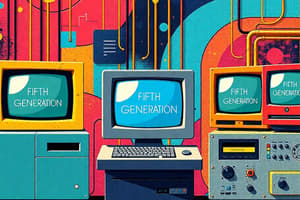Podcast
Questions and Answers
What type of integration powers the fifth generation computers?
What type of integration powers the fifth generation computers?
- ULSI (correct)
- Robotic processes
- AI
- VLSI
Which of the following is not a component of modern computers?
Which of the following is not a component of modern computers?
- Solid-state drive
- Graphics processing unit (GPU)
- Floppy disk drive (correct)
- Random access memory (RAM)
What is the primary function of input devices in a computer system?
What is the primary function of input devices in a computer system?
- Display output to the user
- Execute program instructions
- Insert raw data for processing (correct)
- Store data permanently
Which type of processing machines are part of the fifth generation computers?
Which type of processing machines are part of the fifth generation computers?
Which technology is NOT associated with the fifth generation computers?
Which technology is NOT associated with the fifth generation computers?
Which generation of computers was characterized by the advent of Integrated Circuits (ICs)?
Which generation of computers was characterized by the advent of Integrated Circuits (ICs)?
What technology significantly reduced the size of transistors and allowed for building Integrated Circuits (ICs)?
What technology significantly reduced the size of transistors and allowed for building Integrated Circuits (ICs)?
Which component replaced punch cards as a means of input in the third generation of computers?
Which component replaced punch cards as a means of input in the third generation of computers?
In which generation of computers were very large-scale integration (VLSI) technologies very popular?
In which generation of computers were very large-scale integration (VLSI) technologies very popular?
Which type of machines, such as personal computers (PCs), laptops, and PDAs, were introduced in the fourth generation of computers?
Which type of machines, such as personal computers (PCs), laptops, and PDAs, were introduced in the fourth generation of computers?
Which generation of computers saw the emergence of new operating systems such as IBM 360 & 370 families and DPD 11?
Which generation of computers saw the emergence of new operating systems such as IBM 360 & 370 families and DPD 11?
What is one of the ways AI technology can impact computers?
What is one of the ways AI technology can impact computers?
Which technology is still in its infancy according to the text?
Which technology is still in its infancy according to the text?
What was the size of the first data storage based on vacuum tubes?
What was the size of the first data storage based on vacuum tubes?
Which of the following is NOT mentioned as an impact area of AI in the text?
Which of the following is NOT mentioned as an impact area of AI in the text?
What will heavily replace existing binary processing in modern computers when quantum computing advances?
What will heavily replace existing binary processing in modern computers when quantum computing advances?
In terms of size reduction, which field has experienced exponential decrease according to the text?
In terms of size reduction, which field has experienced exponential decrease according to the text?
Flashcards are hidden until you start studying
Study Notes
Generations of Computers
- Fifth Generation (2010-Present): powered by ultra-large-scale integration (ULSI), artificial intelligence (AI), and robotic processes.
- Characteristics of Fifth Generation: IBM Watson, multicore processing machines, distributed processing machines, and AI-enabled mobile devices and tablets.
- Although AI started before 2010, its higher level of influence began in the present decade.
Components of Modern Computer
- Modern computers undergo changes in software and HW components.
- Input Devices: connected to the computer to insert raw data in different formats for processing purposes.
History of Computers
- Second Generation (1947-1962): Transistor Technology.
- Characteristics of Second Generation: first commercial computer (UNIVAC 1), IBM launched 650 and 700 series computers, emergence of computer programming languages, and assembly languages.
History of Computers (continued)
- Third Generation (1963-1971): Integrated Circuits or ICs.
- Characteristics of Third Generation: advent of silicon material, reduction in transistor size, ICs for electronic circuitries, and ability to run multiple applications simultaneously.
History of Computers (continued)
- Fourth Generation (1971-2010): Very Large-scale Integration (VLSI).
- Characteristics of Fourth Generation: popularity with the masses, emergence of new companies and manufacturers, introduction of personal computers (PCs), laptops, personal digital assistants (PDAs), and other computer machines.
Future Machines
- Artificial Intelligence (AI): will impact computers heavily, and involves technologies such as augmented reality, virtual reality, voice recognition, text interpretation, image processing, and motion detection.
- Quantum Computing: still in its infancy, with limited quantum information processing, and a potential to replace existing binary processing.
- Nanotechnology: involves decreasing HW size exponentially, with significant advancements in electronics and computer technology.
Studying That Suits You
Use AI to generate personalized quizzes and flashcards to suit your learning preferences.




